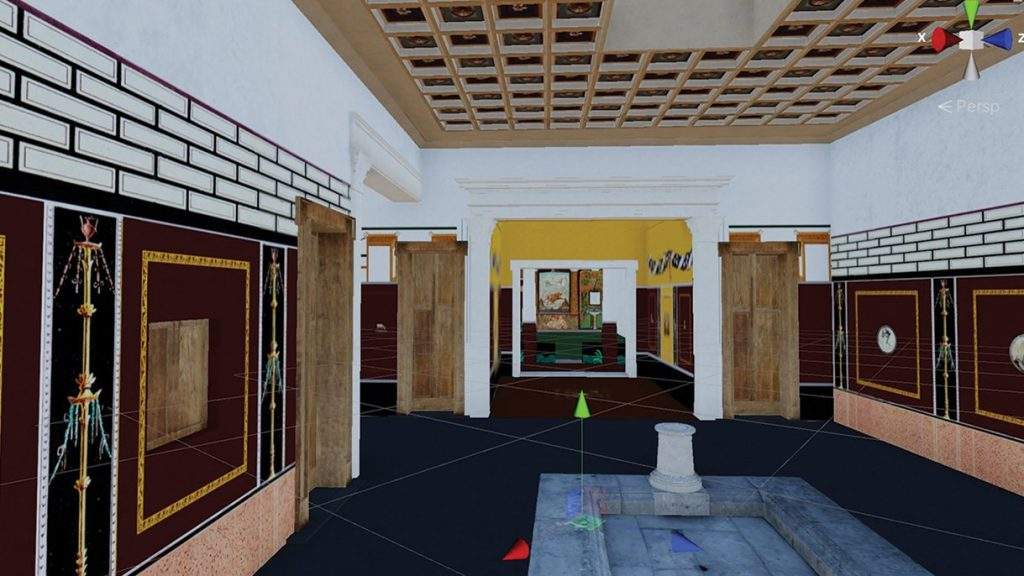What did a house in ancient Pompeii look like and how was it furnished? What were the spaces that most appealed to ancient Pompeians? Two Italian archaeologists from the University of Lund (Sweden), Danilo Campanaro and Giacomo Landeschi have used 3-D technologies to reconstruct Pompeian domestic space and eye-tracking systems to understand how its inhabitants moved, and have published the results of their research in the Cambridge University journal Antiquity. Their research presents a methodology in which eye-tracking techniques based on virtual reality and 3-D geographic information systems (3-D GIS) are used to understand how people lived inside a Pompeian house and what choices guided ancient Pompeians in their interior decoration choices.
Ancient literary sources, including Cicero, Pliny, Seneca, Vitruvius and many others, “emphasize the importance of sight and the act of looking in Roman domestic architecture,” the two authors explain in the paper. “Accordingly, scholars have studied such sources in the context of the material remains of Pompeii and Herculaneum. The results suggest that optical axiality played a key role in the apperception of the Roman house and its socio-political significance.” However, some questions remain to be clarified: for example, how spaces within Roman houses were visible to visitors and how house design and visual space contributed to the social atmosphere.
The method followed by Campanaro and Landeschi followed several steps: witheye-tracking technology (also known as oculometry), which is used to detect eye movements in order to understand which stimuli the most interesting information for the observer comes from, the user’s visual attention was measured in virtual reality, after which a data output was generated for export to software, and finally the data was imported into a 3D GIS environment. For the experiment, a 3D reconstruction of the House of the Greek Epigrams in Pompeii was made using the program 3D Studio Max, which was then imported into Unity, an engine for virtual reality experiences. “This software,” the two researchers explain, “enabled a physics-based simulation of lighting. For the specific purpose of this research, two very different scenarios were chosen: winter solstice sunrise and summer solstice noon. The system recorded the visual experience of the study participants (five Caucasian females of different ages).”
The users’ visual experiences (gaze, fixation and movement) within a virtually reconstructed Pompeian house were, as mentioned, collected and imported into a GIS environment. “Managing data derived from the virtual reality eye tracker in a GIS space,” the study further states, “can present interesting new scenarios for research and analysis of human-environment interaction (e.g., to investigate how lighting affected the social experience of elements such as graffiti and wall paintings). It is possible to query the geodatabase and automatically select areas with higher levels of visual attention, and to understand the order in which objects are viewed and the positions assumed in space by the user. Multiple sessions can be integrated and large amounts of data can be handled to detect patterns that may relate to particular features of the virtual space examined. Despite the important achievements of visibility studies in the emerging literature mentioned above, a human-centered form of analysis has never been fully realized. This workflow introduces a more dynamic approach to overcome the significant limitations posed by most traditional GIS-based studies.”
The conclusion of the study is that the landlords of ancient Pompeii could use the decorative elements of their dwellings to stimulate the senses of their visitors in order to get social and political messages across more easily, e.g., the economic status of the owner, his power. Tools such as those pioneered by Campanaro and Landeschi could, according to the two scholars, “go beyond the boundaries of the specific area of interest to involve all archaeological contexts in which visual properties and people are intertwined, or in which visual properties are manipulated to solicit behavior.”
 |
| What captured the attention of guests in an ancient house in Pompeii? The study of two archaeologists |
Warning: the translation into English of the original Italian article was created using automatic tools. We undertake to review all articles, but we do not guarantee the total absence of inaccuracies in the translation due to the program. You can find the original by clicking on the ITA button. If you find any mistake,please contact us.